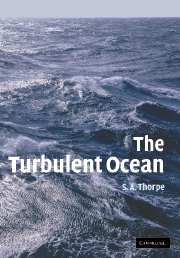Book contents
- Frontmatter
- Contents
- Preface
- Structure and résumé
- Acknowledgements
- 1 Heat, buoyancy, instability and turbulence
- 2 Neutral stability: internal waves
- 3 Instability and transition to turbulence in stratified shear flows
- 4 Convective instabilities
- 5 Instability and breaking of internal waves in mid-water
- 6 The measurement of turbulence and mixing
- 7 Fine-structure, transient-structures, and turbulence in the pycnocline
- 8 The benthic boundary layer
- 9 The upper ocean boundary layer
- 10 Shallow seas
- 11 Boundary layers on beaches and submarine slopes
- 12 Topographically related turbulence
- 13 Large-scale waves, eddies and dispersion
- 14 Epilogue
- Appendices
- References
- Index of laboratory experiments
- Subject index
- Plate section
11 - Boundary layers on beaches and submarine slopes
Published online by Cambridge University Press: 05 June 2012
- Frontmatter
- Contents
- Preface
- Structure and résumé
- Acknowledgements
- 1 Heat, buoyancy, instability and turbulence
- 2 Neutral stability: internal waves
- 3 Instability and transition to turbulence in stratified shear flows
- 4 Convective instabilities
- 5 Instability and breaking of internal waves in mid-water
- 6 The measurement of turbulence and mixing
- 7 Fine-structure, transient-structures, and turbulence in the pycnocline
- 8 The benthic boundary layer
- 9 The upper ocean boundary layer
- 10 Shallow seas
- 11 Boundary layers on beaches and submarine slopes
- 12 Topographically related turbulence
- 13 Large-scale waves, eddies and dispersion
- 14 Epilogue
- Appendices
- References
- Index of laboratory experiments
- Subject index
- Plate section
Summary
Introduction
This chapter describes the nature of turbulent flow induced by waves and other processes in two contrasting regions where the presence of a sloping boundary has profound effects.
Much of the energy of surface waves that have sometimes crossed the full width of ocean basins (Snodgrass et al., 1966) is eventually dissipated by turbulence in the near-shore zone. Perhaps the most familiar, violent and extensive turbulence anywhere in the ocean is that produced in long lines by plunging breakers formed as waves of approximately symmetrical shape in deep water encounter a gently shelving and uniform beach and enter the surf zone, the gradually shoaling region between the location of the first breaking of the shoreward-propagating waves and their final demise in the swath zone at the shoreline itself. Waves travel and arrive in groups; as those who have paddled at the edge of a sandy beach know, about every seventh – but with substantial variation – wave is higher than the others. Breaking is a transitional process. After breaking, the waves continue to advance shoreward, no longer symmetrical but commonly in the form of a hydraulic jump or turbulent bore, leaving a floating trail of foam. Patterns visible in foam indicate a degree of order and structure both within the breakers themselves and within the turbulence left as bores advance through the surf zone.
- Type
- Chapter
- Information
- The Turbulent Ocean , pp. 291 - 320Publisher: Cambridge University PressPrint publication year: 2005



